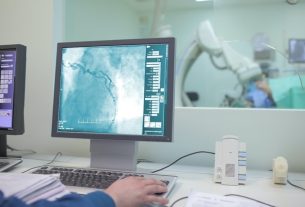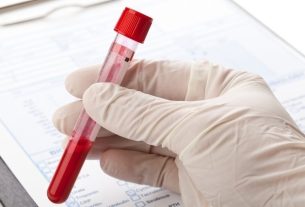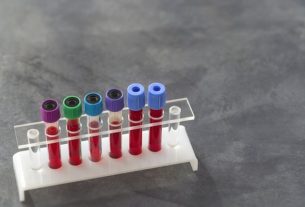The myelogram is a diagnostic test indicated to evaluate the functioning of the bone marrow, which is responsible for producing blood cells, and is requested by the doctor when there is a suspicion of diseases that could interfere with this production, such as leukemia, lymphoma or myeloma, for example.
This exam, also known as bone marrow aspiration puncture, is carried out by the hematologist using a thick needle, capable of reaching the inner part of the hip bone, sternum or thigh, where the bone marrow, popularly known as marrow, is located. This requires a small localized anesthesia to reduce pain and discomfort during the procedure.
After collecting the material, the pathologist will analyze the blood sample and identify possible changes, such as a decrease in the production of blood cells, the production of defective or cancerous cells, for example, and the results must be interpreted by the hematologist.

What is it for
The myelogram is indicated to investigate, diagnose, monitor the treatment and evolution of health conditions that affect the bone marrow, such as:
- unexplained anemia;
- Aplastic anemia;
- Hemochromatosis;
- Myelodysplastic syndrome;
- Multiple myeloma;
- Leukemias;
- Hodgkin lymphoma;
- Non-Hodgkin’s lymphoma;
- Leukopenia;
- Polycythemia vera;
- Mielofibrose;
- Amyloidosis;
- Gaucher disease;
- Chronic infections, such as tuberculosis or visceral leishmaniasis;
- Metastasis of a serious cancer to the bone marrow;
- Fever of unknown cause.
The myelogram is normally requested after changes in the blood count, in which changes in the function or shape of the blood cells are identified, few blood cells or a large number of immature cells, for example, being indicative of changes in the bone marrow.
Therefore, the result of the myelogram is very important in the diagnosis of various diseases, allowing appropriate treatment. In some cases, a bone marrow biopsy may also be necessary, a more complex and time-consuming test, as it is necessary to remove a piece of bone, but often important to provide more details about the marrow. Find out what a bone marrow biopsy is for and how it is performed.
Which doctor does the myelogram?
The specialist doctor for performing the myelogram is the hematologist, who must also advise how the exam is performed, preparation and the risks of the procedure, in addition to interpreting the results.
Taking care of your health has never been easier!
How is done
The myelogram is performed by the hematologist or onco-hematologist at the hospital or specialized clinics, using a local anesthetic, and sedation if necessary, and generally lasts 10 to 20 minutes.
To perform the myelogram, the doctor must follow some steps, which include:
- Clean and aseptic the area to avoid contamination, with antiseptic solutions, such as povidone or chlorhexidine;
- Perform local anesthesia, on the skin and on the outside of the bone. If necessary, sedation can be performed by applying the sedative directly into the vein;
- Make a puncture with a special, thicker needle to pierce the bone and reach the bone marrow;
- Connect a syringe to the needle to aspirate and collect the desired material;
- Remove the needle and compress the area with gauze to prevent bleeding;
- Apply a bandage to the area.
Generally, the bones on which myelograms are performed are the sternum, located in the chest, the iliac crest, which is the bone located in the pelvis region, and the tibia, the leg bone, which is mostly done in children.
After collecting the material, it is necessary to analyze and interpret the result, which can be done using a slide, by the doctor himself, as well as using machines specialized in analyzing blood cells.
How to prepare
Some precautions are important to prepare for the myelogram, such as:
- Tell your doctor if you are allergic to anesthetics, iodine, latex or any other type of medicine;
- Inform your doctor about the use of anticoagulant medicationssuch as warfarin, heparin, rivaroxaban, acetylsalicylic acid or clopidogrel, as the doctor may advise you to stop these medications a few days before the exam;
- Bring a list of all medicationsvitamins and nutritional supplements that you take frequently;
- Avoid taking medications that have not been prescribed by your doctorincluding home remedies and teas;
- Fasting for the time determined by your doctorif sedation is necessary to carry out the exam;
- Bring a companion on the day of the examin the case of sedation;
Furthermore, it is important to clarify with the doctor any doubts about the exam and the possible risks of the procedure.
Care after the exam
After performing the myelogram, the dressing must be kept on for 24 hours, avoiding getting it wet, and it is recommended not to take a shower during this period, or use a bathtub, swimming pool or sauna. Furthermore, it is recommended to avoid exertion or physical activity for one to two days after the exam, as per medical advice.
After the myelogram, it is possible for the person to feel some pain in the place where the bone marrow puncture was made, so the doctor may recommend the use of painkillers, such as paracetamol.
Possible risks
Generally, the myelogram is a quick procedure with rare complications, however, it is possible to experience pain or discomfort at the puncture site, as well as bleeding, hematoma or infection. Collecting the material may be necessary, in a few cases, due to insufficient or inadequate quantity of sample for analysis.
When to go to the doctor
It is important to consult the doctor who performed the myelogram or go to the emergency room if symptoms such as:
- Swelling at the puncture site;
- Pain that does not improve;
- Presence of secretion at the puncture site;
- Redness at the site;
- Fever.
In addition, medical help should be sought if heavy or excessive bleeding occurs at the puncture site, which soaks through the dressing or does not improve when pressing on the site.
Who shouldn’t do
Myelogram should not be done in people who have severe clotting disorders or disseminated intravascular coagulopathy. And people with thrombocytopenia, the doctor may recommend platelet transfusion before the exam.
Furthermore, puncture of the sternum bone in the chest should not be done in children under 12 years of age, or in people who have problems with bone resorption or multiple myeloma, due to the increased risk of perforation of the sternum or mediastinum.

Sign up for our newsletter and stay up to date with exclusive news
that can transform your routine!
Warning: Undefined array key "title" in /home/storelat/public_html/wp-content/plugins/link-whisper-premium/templates/frontend/related-posts.php on line 12
Warning: Undefined array key "title_tag" in /home/storelat/public_html/wp-content/plugins/link-whisper-premium/templates/frontend/related-posts.php on line 13



